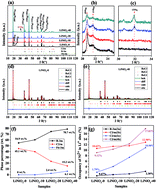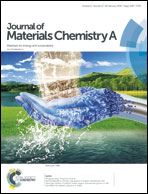A novel strategy to significantly enhance the initial voltage and suppress voltage fading of a Li- and Mn-rich layered oxide cathode material for lithium-ion batteries†
Abstract
In this work, a Li[Li0.2Ni0.13Co0.13Mn0.54]O2–xLiNiO2 composite cathode with a Ni-rich bulk phase and in situ precipitated Ni-rich spinel-like phase on the surface has been built up to significantly enhance the initial voltage and suppress the voltage fading during cycling and consequently effectively increase the energy density. It is a novel strategy to combine Ni-ion substitution in the bulk phase and in situ precipitated spinel-like phase on the surface of particles in a facile one-step process. The initial average voltage of the Li[Li0.2Ni0.13Co0.13Mn0.54]O2–0.4LiNiO2 cathode largely improves to 3.8 V and the capacity reaches 277 mA h g−1. It delivers a voltage retention of 94.1% and a capacity retention of 93.3% after 500 cycles. Structure and morphology are characterized using X-ray diffraction (XRD) and high-resolution transmission electron microscopy (HRTEM). The electrochemical performance is investigated using a galvanostatic charge and discharge test. Results show that the Ni2+ ions can exchange with Li+ ions to occupy the Li+ ion sites in the bulk phase. Moreover, the Ni2+ ions also easily diffuse into the surface region of the Li[Li0.2Ni0.13Co0.13Mn0.54]O2–xLiNiO2 (x = 0.0–0.4) particle to form a Ni-rich LiNiyMn2−yO4 spinel-like phase in situ precipitated coating layer. The Ni2+ ion substitution in the bulk phase can effectively suppress the formation of the spinel-like phase during cycling and the in situ precipitated surface coating of the Ni-rich spinel-like phase can significantly enhance the structure stability of the interface between the surface of the electrode and the electrolyte during cycling.



 Please wait while we load your content...
Please wait while we load your content...